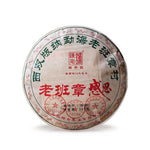Cloud Tea
Cloud Tea has a rich background rooted in ancient traditions and specific regional characteristics. This tea's development and distinct quality are deeply tied to its history and the unique geographical areas where it is grown.
Historical Background
Cloud Tea's history traces back to ancient times, often associated with the mystic and serene environments of Chinese temples and monasteries. Monks used to cultivate and consume this tea for meditation, given its subtle and soothing effects.
Ancient texts and legends suggest that Cloud Tea was praised for its delicate flavor and health benefits. Historically, it was reserved for the elite and used during significant ceremonies.
Bestsellers

2022 Pu-Erh Tea Sample Box (Free Shipping)

2022 Yi Pin Chen Sheng Raw Pu-erh Tea Sample Box

2022 Lao Ban Zhang Raw Pu-erh Tea

2022 Na Ka Raw Pu-erh Tea

2023 Ban Zhang Yin Xiang Raw Pu-erh Tea

2017 Rong Pu Ripe Pu-erh Tea
Gradually, Cloud Tea became accessible to the broader public, maintaining its revered status. Its production techniques have been handed down through generations, ensuring its legacy and traditional methods are preserved.
Geographical Indications
Grown in the misty, high-altitude regions of China, primarily in provinces like Fujian and Zhejiang, Cloud Tea benefits from the humid and cool climate. The geographical conditions contribute to the tea’s unique taste and quality.
The soil composition in these areas is rich in minerals, enhancing the tea leaves' flavor profile. Also, the frequent fog and cloud cover protect the leaves from direct sunlight, allowing them to develop distinct aroma and tenderness.
Given its specific growing conditions, Cloud Tea carries geographical indications that assure consumers of its authenticity and superior quality. This regional specificity is a key factor in its exceptional characteristics and historical prestige.
Cultivation

Cultivating cloud tea involves specific farming techniques and meticulous harvesting methods. These practices ensure the unique flavor and quality of the tea.
Farming Techniques
For cloud tea, you must consider the unique microclimates in which it thrives. Typically, high-altitude regions with consistent mist and cloud cover are ideal. This environment enhances the tea's delicate flavor and aroma.
You should pay attention to soil quality and composition. Rich, well-draining soil supports healthy plant growth. Use organic fertilizers to maintain the natural balance and avoid synthetic chemicals. Employing terracing helps in managing steep slopes and prevents soil erosion.
Pruning and regular maintenance are crucial. Prune the tea bushes to allow better air circulation and sunlight penetration. This practice reduces the risk of disease and promotes robust growth. You should also mulch around the plants to retain moisture and improve soil structure.
Harvesting Methods
Harvesting cloud tea demands precision and care. Typically, you should hand-pick the leaves to avoid damage and ensure only the tenderest leaves are selected. The ideal time for harvesting is early morning when the leaves are still cool and dewy.
You must select the top two leaves and a bud, known for their superior quality. Picking in this manner preserves the plant’s integrity and encourages continuous growth. You must handle the picked leaves gently to prevent bruising.
After picking, quickly transport the leaves to the processing area. Delays can affect the tea’s flavor and quality. During this phase, focus on preserving the freshness and delicate essence that characterizes cloud tea.
Lao Ban Zhang

2024 Lao Ban Zhang Ripe Pu-erh Tea

2022 Lao Ban Zhang Raw Pu-erh Tea

2023 Ding Feng- Lao Ban Zhang Raw Pu-erh Tea (42g)

2024 Xiao Ban Zhang Raw Pu-erh Tea

2020 Lao Ban Zhang Raw Pu-erh Tea 125g

2025 Lao Ban Zhang -Gan En Raw Pu-erh Tea 357g
Flavor Profile

Cloud tea offers a nuanced sensory experience with distinct aromatic and taste characteristics.
Aroma Characteristics
Cloud tea produces a unique and inviting scent. The aroma often features a blend of floral and fruity notes. Jasmine, orchid, and roses might be the first fragrances to greet your senses. There's also a hint of fresh grass or earthy undertones, which adds complexity.
Some varieties may include subtle hints of citrus or even a touch of spice. These diverse aroma profiles contribute to an overall refreshing and light experience. Freshly brewed cups often release layers of smells, enticing you further.
Taste Notes
The taste of cloud tea is equally intricate. It typically starts with a light, sweetness that can remind you of honey or fresh fruits. A lingering mild bitterness often follows, balancing the initial sweetness.
Expect secondary flavors to emerge, such as nutty tones or even a creamy texture. This variety keeps each sip engaging. Altogether, the blend of sweetness, mild bitterness, and secondary flavors creates a harmonious and enjoyable drink.
Brewing Cloud Tea
Brewing Cloud Tea involves specific preparation methods and precise control of brewing temperature to unlock its delicate flavors. Understanding these aspects will help you achieve the perfect cup.
Preparation Methods
To prepare Cloud Tea, start by gathering high-quality loose leaves. Use filtered water for the purest taste, as impurities can alter the tea's flavor.
Start by rinsing the leaves briefly with hot water to awaken their aroma. Then, measure 2 grams of tea leaves per 100ml of water. Place the leaves in a teapot or infuser.
A glass or ceramic teapot is ideal for even heat distribution. Pour hot water over the leaves and let them steep. A steeping time of 3 to 5 minutes is recommended for the best flavor extraction.
Brewing Temperature
The brewing temperature for Cloud Tea should be carefully controlled. Ideal water temperature ranges between 175°F (80°C) and 185°F (85°C).
Boiling water can scorch the leaves, leading to a bitter flavor. Use a thermometer or a temperature-controlled kettle to ensure accuracy. If you don't have these tools, let boiled water cool for a couple of minutes before pouring over the leaves.
Maintaining the right temperature preserves the tea's subtle flavor notes and prevents bitterness. Adjust steeping time and temperature based on your taste preference and the specific type of Cloud Tea used.
Health Benefits
Cloud tea is rich in antioxidants, which can help protect your cells from damage. These antioxidants may reduce inflammation and lower the risk of various chronic diseases.
You might find that cloud tea boosts your metabolism. This could aid in weight management, making it easier to maintain a healthy weight.
Drinking cloud tea regularly can improve your heart health. It may lower blood pressure and reduce bad cholesterol levels, contributing to a healthier cardiovascular system.
Amino acids in cloud tea can enhance your mental clarity and focus. You may feel more alert and perform cognitive tasks more effectively.
Cloud tea contains compounds that support your immune system. This can help your body fend off illnesses and recover more quickly.
Incorporate cloud tea into your routine to take advantage of its potential digestive benefits. It might soothe your digestive tract and improve overall gut health.
Experience reduced stress and a calmer state of mind by consuming cloud tea. It can have a relaxing effect, helping you manage stress better.
Here’s a summary of cloud tea’s health benefits:
| Benefit | Description |
|---|---|
| Antioxidant-rich | Protects cells from damage |
| Boosts metabolism | Aids in weight management |
| Improves heart health | Lowers blood pressure and bad cholesterol |
| Enhances mental clarity | Increases focus and alertness |
| Supports immune system | Helps fend off illnesses |
| Aids digestion | Soothes digestive tract |
| Reduces stress | Promotes a calm state of mind |
Cultural Significance

Cloud tea holds a unique place in history, deeply embedded in cultural rituals and literature. It offers rich symbolism and forms a cornerstone in various ceremonies.
Rituals and Ceremonies
Cloud tea is often used in traditional tea ceremonies across several Asian cultures. Chinese tea ceremonies emphasize respect and tranquility. In these ceremonies, every movement, from pouring water to serving tea, follows a precise and symbolic series of steps.
In Japanese culture, cloud tea ceremonies focus on harmony and mindfulness. The tea master prepares the tea with great attention to detail and form, reflecting the importance of aesthetics and spiritual balance.
In social gatherings, cloud tea signifies hospitality and respect. Offering it to guests is considered an honor, and sharing a pot signifies friendship and unity. Festivals often incorporate cloud tea rituals to celebrate heritage and community.
Symbolism in Literature
Cloud tea frequently appears as a motif in literature and art, symbolizing peace, purity, and enlightenment. In Chinese poetry, it often represents the inner journey and tranquility, offering a metaphor for life's complexity and simplicity.
In Japanese haiku, the fleeting nature of the tea's aroma captures the essence of transient beauty. Authors use it to evoke a sense of ephemerality and cherished moments.
Myths and folklore also portray cloud tea as a divine drink, gifted by the gods for its calming and life-enhancing properties. This symbolism underscores its esteemed status in various cultures, often depicted as a bridge between the earthly and the divine.
Market and Trade

Cloud tea has grown in popularity, partly due to its unique flavor and health benefits. Its exportation, primarily from specific mountainous regions, continues to shape global trends.
Global Demand
Cloud tea has seen a significant increase in global demand. This is largely driven by growing consumer awareness of its distinctive taste and potential health benefits. Countries in North America and Europe have become major importers. Retailers benefit from marketing cloud tea as a premium product, and health-conscious consumers are particularly drawn to its antioxidant properties.
In Asia, traditional tea markets have also embraced cloud tea. Online sales platforms have facilitated easier access to international consumers, boosting demand. Specialty tea shops and high-end supermarkets stock cloud tea to cater to an affluent clientele looking for exclusive beverages.
Exportation Practices
Exportation of cloud tea primarily comes from mountainous regions where it is grown. Economies that produce cloud tea often rely on both small-scale farmers and larger agricultural enterprises. Quality control is critical to maintain the tea’s reputation. Sustainable practices are increasingly adopted, emphasizing organic farming and reducing environmental impact.
The tea leaves undergo careful hand-picking and processing before export. Many exporters partner with international distributors to ensure that cloud tea reaches global markets efficiently. Packaging is often designed to preserve freshness during long transit times. Certification processes, such as fair trade and organic labels, enhance the product's appeal in international markets, ensuring transparency and ethical standards.
Conservation Efforts

Conservation efforts for cloud tea focus on protecting its natural habitats.
Key initiatives include reforestation projects and sustainable farming practices. These initiatives aim to balance tea cultivation with environmental preservation.
Local communities play a crucial role. Involving them ensures the adoption of eco-friendly techniques.
Key components of conservation:
- Reforestation: Planting native trees to restore ecosystems.
- Sustainable Farming: Using organic fertilizers and pest management.
- Water Conservation: Implementing efficient irrigation systems.
You can support conservation efforts by choosing sustainably sourced cloud tea and participating in local preservation programs.
← Older post Newer post →
